The Effect of Targeted Hyperoxemia on Brain Immunohistochemistry after Long-Term, Resuscitated Porcine Acute Subdural Hematoma and Hemorrhagic Shock
Abstract
1. Introduction
2. Results
3. Discussion
Limitations of the Study
4. Materials and Methods
4.1. Animals
4.2. Experimental Protocol
4.3. Immunohistochemistry
4.4. Statistical Analysis
5. Conclusions
Supplementary Materials
Author Contributions
Funding
Institutional Review Board Statement
Informed Consent Statement
Data Availability Statement
Acknowledgments
Conflicts of Interest
References
- Cannon, J.W. Hemorrhagic Shock. N. Engl. J. Med. 2018, 378, 370–379. [Google Scholar] [CrossRef] [PubMed]
- Demiselle, J.; Calzia, E.; Hartmann, C.; Messerer, D.A.C.; Asfar, P.; Radermacher, P.; Datzmann, T. Target arterial PO2 according to the underlying pathology: A mini-review of the available data in mechanically ventilated patients. Ann. Intensive Care 2021, 11, 88. [Google Scholar] [CrossRef] [PubMed]
- Alali, A.S.; Temkin, N.; Vavilala, M.S.; Lele, A.V.; Barber, J.; Dikmen, S.; Chesnut, R.M. Matching early arterial oxygenation to long-term outcome in severe traumatic brain injury: Target values. J. Neurosurg. 2019, 132, 537–544. [Google Scholar] [CrossRef] [PubMed]
- Rezoagli, E.; Petrosino, M.; Rebora, P.; Menon, D.K.; Mondello, S.; Cooper, D.J.; Maas, A.I.R.; Wiegers, E.J.A.; Galimberti, S.; Citerio, G.; et al. High arterial oxygen levels and supplemental oxygen administration in traumatic brain injury: Insights from CENTER-TBI and OzENTER-TBI. Intensive Care Med. 2022, 48, 1709–1725. [Google Scholar] [CrossRef] [PubMed]
- Datzmann, T.; Münz, F.; Hoffmann, A.; Moehrke, E.; Binzenhöfer, M.; Gröger, M.; Kapapa, T.; Mathieu, R.; Mayer, S.; Zink, F.; et al. An exploratory study investigating the effect of targeted hyperoxemia in a randomized controlled trial in a long-term resuscitated model of combined acute subdural hematoma and hemorrhagic shock in cardiovascular healthy pigs. Front. Immunol. 2023, 14, 1123196. [Google Scholar] [CrossRef]
- Datzmann, T.; Kapapa, T.; Scheuerle, A.; McCook, O.; Merz, T.; Unmuth, S.; Hoffmann, A.; Mathieu, R.; Mayer, S.; Mauer, U.M.; et al. In-depth characterization of a long-term, resuscitated model of acute subdural hematoma-induced brain injury. J. Neurosurg. 2021, 134, 223–234. [Google Scholar] [CrossRef] [PubMed]
- Ahn, E.S.; Robertson, C.L.; Vereczki, V.; Hoffman, G.E.; Fiskum, G. Normoxic ventilatory resuscitation following controlled cortical impact reduces peroxynitrite-mediated protein nitration in the hippocampus. J. Neurosurg. 2008, 108, 124–131. [Google Scholar] [CrossRef] [PubMed]
- Blasiole, B.; Bayr, H.; Vagni, V.A.; Janesko-Feldman, K.; Cheikhi, A.; Wisniewski, S.R.; Long, J.B.; Atkins, J.; Kagan, V.; Kochanek, P.M. Effect of hyperoxia on resuscitation of experimental combined traumatic brain injury and hemorrhagic shock in mice. Anesthesiology 2013, 118, 649–663. [Google Scholar] [CrossRef] [PubMed]
- Ciosek, J.; Cisowska, A.; Dabrowski, R. Galanin affects vasopressin and oxytocin release from the hypothalamo-neurohypophysial system in haemorrahaged rats. J. Physiol. Pharmacol. 2003, 54, 233–246. [Google Scholar] [PubMed]
- Yang, M.; Deng, S.; Jiang, J.; Tian, M.; Xiao, L.; Gong, Y. Oxytocin Improves Intracerebral Hemorrhage Outcomes by Suppressing Neuronal Pyroptosis and Mitochondrial Fission. Stroke 2023, 54, 1888–1900. [Google Scholar] [CrossRef] [PubMed]
- Denoix, N.; Merz, T.; Unmuth, S.; Hoffmann, A.; Nespoli, E.; Scheuerle, A.; Huber-Lang, M.; Gündel, H.; Waller, C.; Radermacher, P.; et al. Cerebral Immunohistochemical Characterization of the H2S and the Oxytocin Systems in a Porcine Model of Acute Subdural Hematoma. Front. Neurol. 2020, 11, 649. [Google Scholar] [CrossRef] [PubMed]
- Zhang, M.; Shan, H.; Wang, Y.; Wang, T.; Liu, W.; Wang, L.; Zhang, L.; Chang, P.; Dong, W.; Chen, X.; et al. The expression changes of cystathionine-β-synthase in brain cortex after traumatic brain injury. J. Mol. Neurosci. 2013, 51, 57–67. [Google Scholar] [CrossRef] [PubMed]
- Kitagawa, K.; Matsumoto, M.; Ohtsuki, T.; Tagaya, M.; Okabe, T.; Hata, R.; Ueda, H.; Handa, N.; Sobue, K.; Kamada, T. The characteristics of blood-brain barrier in three different conditions—Infarction, selective neuronal death and selective loss of presynaptic terminals--following cerebral ischemia. Acta Neuropathol. 1992, 84, 378–386. [Google Scholar] [CrossRef] [PubMed]
- Denoix, N.; McCook, O.; Scheuerle, A.; Kapapa, T.; Hoffmann, A.; Gündel, H.; Waller, C.; Szabo, C.; Radermacher, P.; Merz, T. Brain Histology and Immunohistochemistry after Resuscitation from Hemorrhagic Shock in Swine with Pre-Existing Atherosclerosis and Sodium Thiosulfate (Na2S2O3) Treatment. Front. Med. 2022, 9, 925433. [Google Scholar] [CrossRef] [PubMed]
- Puccio, A.M.; Hoffman, L.A.; Bayir, H.; Zullo, T.G.; Fischer, M.; Darby, J.; Alexander, S.; Dixon, C.E.; Okonkwo, D.O.; Kochanek, P.M. Effect of short periods of normobaric hyperoxia on local brain tissue oxygenation and cerebrospinal fluid oxidative stress markers in severe traumatic brain injury. J. Neurotrauma 2009, 26, 1241–1249. [Google Scholar] [CrossRef] [PubMed]
- Lång, M.; Skrifvars, M.B.; Siironen, J.; Tanskanen, P.; Ala-Peijari, M.; Koivisto, T.; Djafarzadeh, S.; Bendel, S. A pilot study of hyperoxemia on neurological injury, inflammation and oxidative stress. Acta Anaesthesiol. Scand. 2018, 62, 801–810. [Google Scholar] [CrossRef] [PubMed]
- Vidal-Jorge, M.; Sánchez-Guerrero, A.; Mur-Bonet, G.; Castro, L.; Rădoi, A.; Riveiro, M.; Fernández-Prado, N.; Baena, J.; Poca, M.A.; Sahuquillo, J. Does Normobaric Hyperoxia Cause Oxidative Stress in the Injured Brain? A Microdialysis Study Using 8-Iso-Prostaglandin F2α as a Biomarker. J. Neurotrauma 2017, 34, 2731–2742. [Google Scholar] [CrossRef] [PubMed]
- Kleindienst, A.; Hildebrandt, G.; Kroemer, S.A.; Franke, G.; Gaab, M.R.; Landgraf, R. Hypothalamic neuropeptide release after experimental subarachnoid hemorrhage: In vivo microdialysis study. Acta Neurol. Scand. 2004, 109, 361–368. [Google Scholar] [CrossRef] [PubMed]
- McCook, O.; Scheuerle, A.; Denoix, N.; Kapapa, T.; Radermacher, P.; Merz, T. Localization of the hydrogen sulfide and oxytocin systems at the depth of the sulci in a porcine model of acute subdural hematoma. Neural Regen. Res. 2021, 16, 2376–2382. [Google Scholar] [CrossRef]
- Zwetnow, N.N.; Orlin, J.R.; Wu, W.H.; Tajsic, N. Studies on supratentorial subdural bleeding using a porcine model. Acta Neurochir. 1993, 121, 58–67. [Google Scholar] [CrossRef]
- Timaru-Kast, R.; Meissner, A.; Heimann, A.; Hoelper, B.; Kempski, O.; Alessandri, B. Acute subdural hematoma in pigs: Role of volume on multiparametric neuromonitoring and histology. J. Neurotrauma 2008, 25, 1107–1119. [Google Scholar] [CrossRef] [PubMed]
- O’Donnell, J.C.; Browne, K.D.; Kvint, S.; Makaron, L.; Grovola, M.R.; Karandikar, S.; Kilbaugh, T.J.; Cullen, D.K.; Petrov, D. Multimodal Neuromonitoring and Neurocritical Care in Swine to Enhance Translational Relevance in Brain Trauma Research. Biomedicines 2023, 11, 1336. [Google Scholar] [CrossRef] [PubMed]
- Cloots, R.J.; Gervaise, H.M.; van Dommelen, J.A.; Geers, M.G. Biomechanics of traumatic brain injury: Influences of the morphologic heterogeneities of the cerebral cortex. Ann. Biomed. Eng. 2008, 36, 1203–1215. [Google Scholar] [CrossRef] [PubMed]
- Arnould, A.; Rochat, L.; Azouvi, P.; Van der Linden, M. A multidimensional approach to apathy after traumatic brain injury. Neuropsychol. Rev. 2013, 23, 210–233. [Google Scholar] [CrossRef] [PubMed]
- Read, M.S.; Potter, J.Y.; Brinkhous, K.M. Venom coagglutinin for detection of von Willebrand factor activity in animal plasmas. J. Lab. Clin. Med. 1983, 101, 74–82. [Google Scholar] [PubMed]
- Hinson, J.A.; Michael, S.L.; Ault, S.G.; Pumford, N.R. Western blot analysis for nitrotyrosine protein adducts in livers of saline-treated and acetaminophen-treated mice. Toxicol. Sci. 2000, 53, 467–473. [Google Scholar] [CrossRef] [PubMed][Green Version]
- Merz, T.; Lukaschewski, B.; Wigger, D.; Rupprecht, A.; Wepler, M.; Gröger, M.; Hartmann, C.; Whiteman, M.; Szabo, C.; Wang, R.; et al. Interaction of the hydrogen sulfide system with the oxytocin system in the injured mouse heart. Intensive Care Med. Exp. 2018, 6, 41. [Google Scholar] [CrossRef] [PubMed]
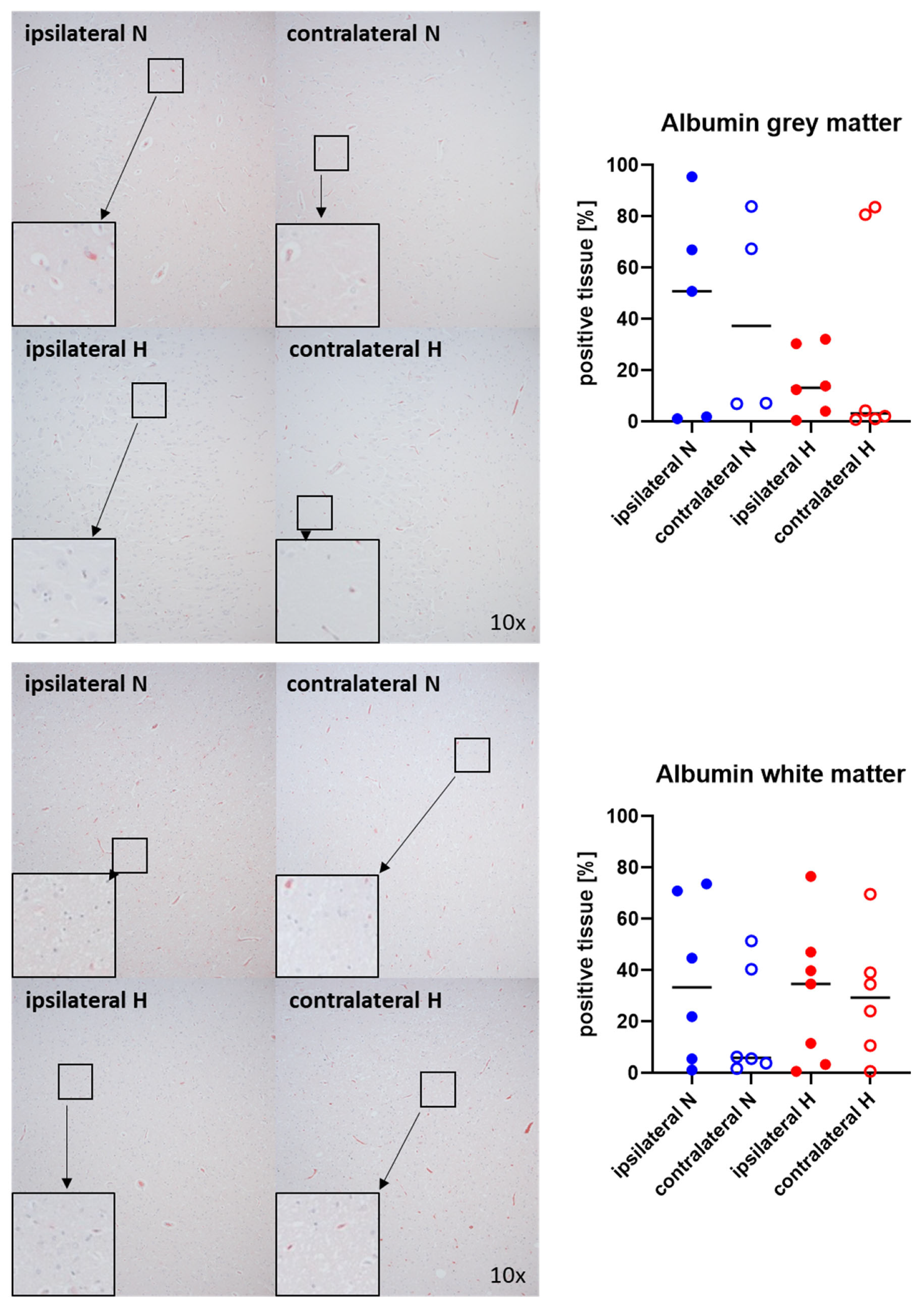
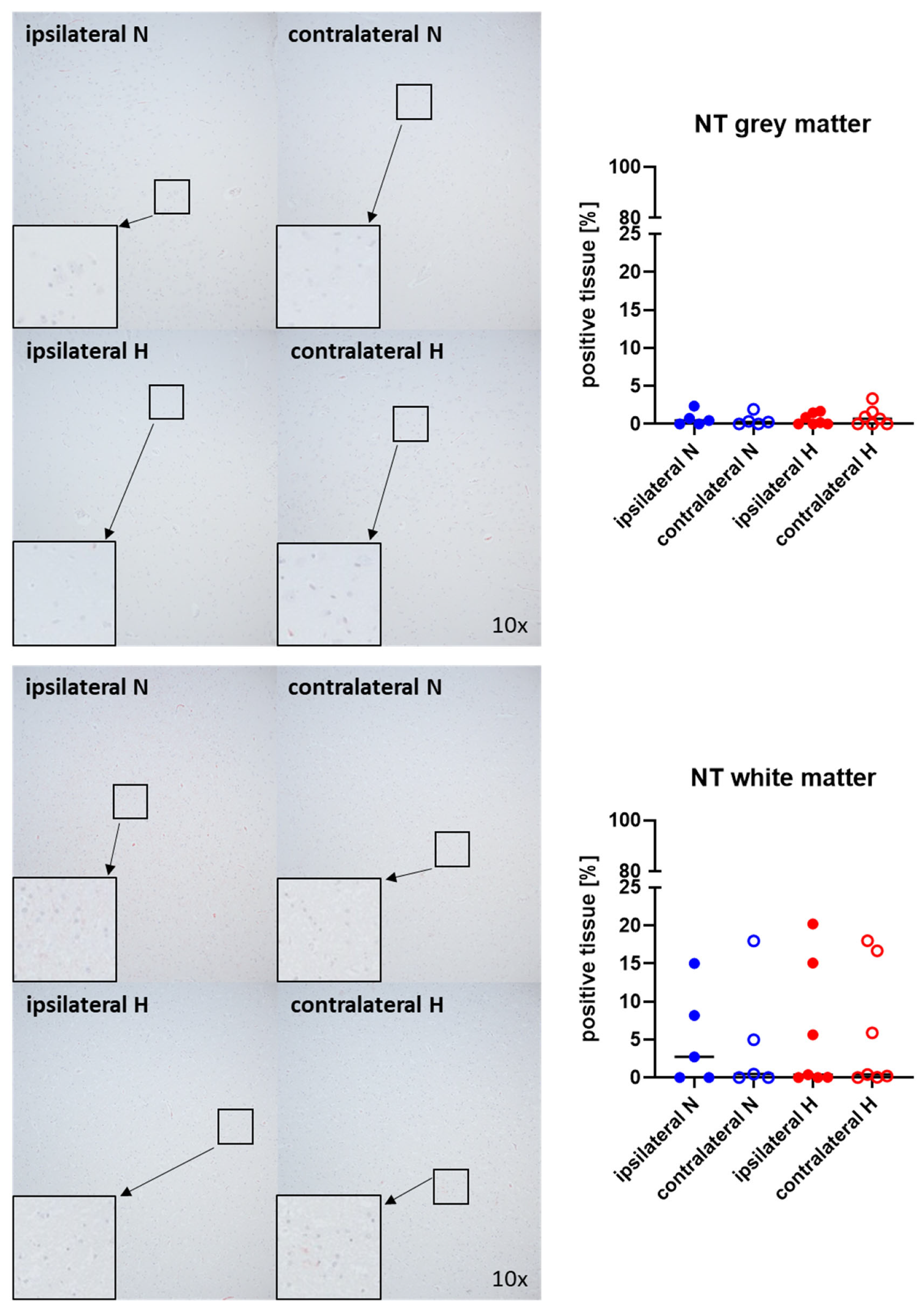
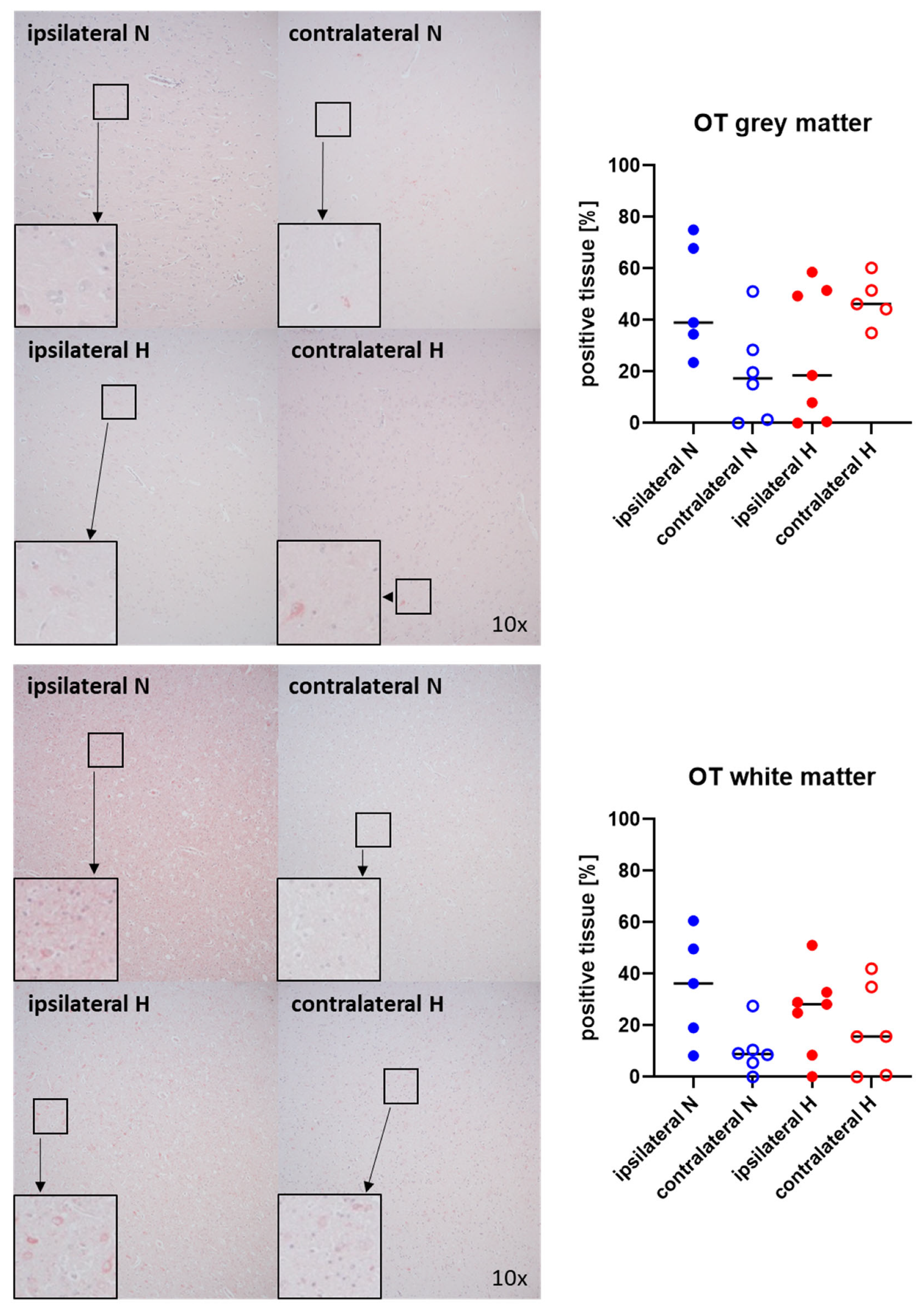
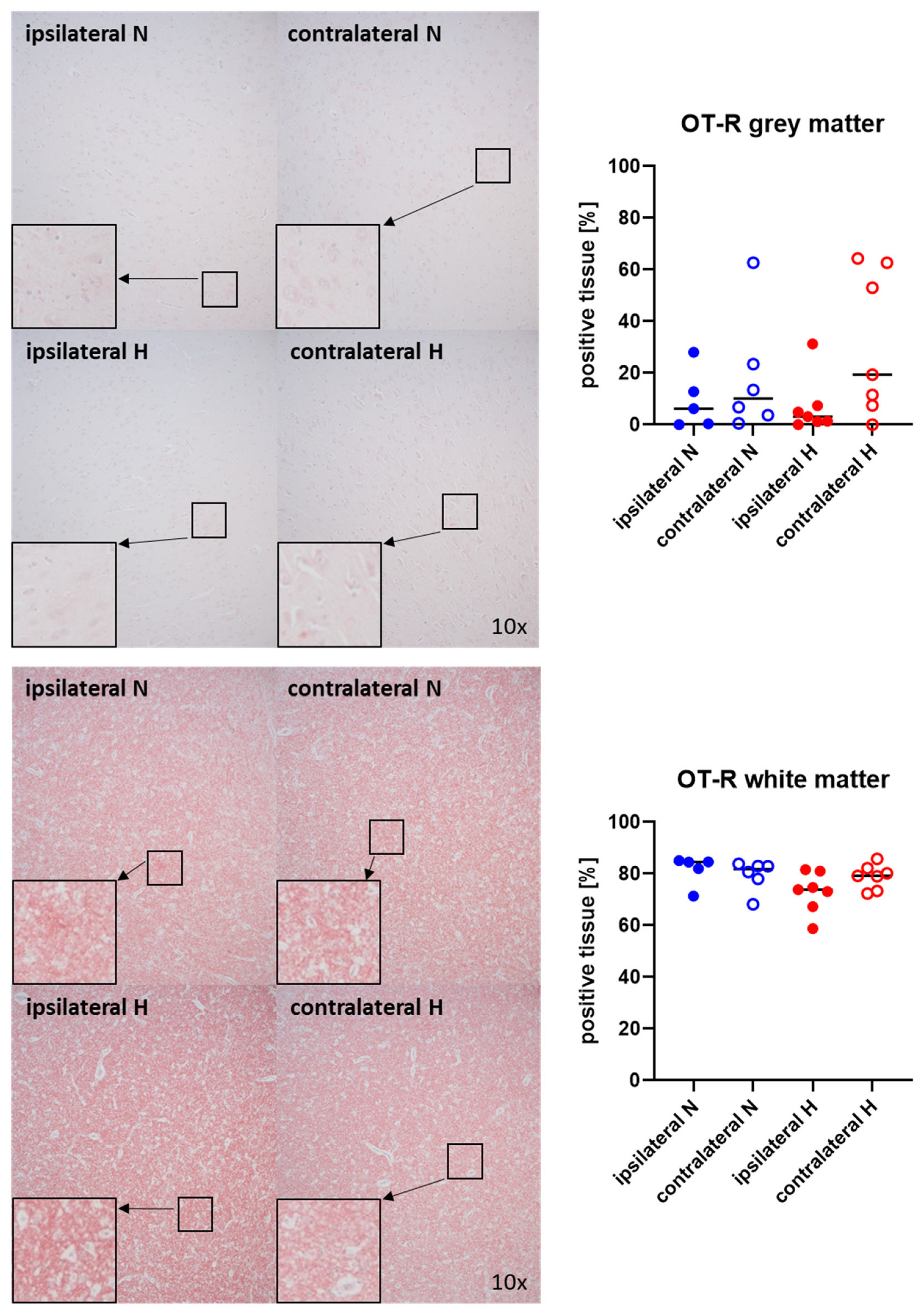
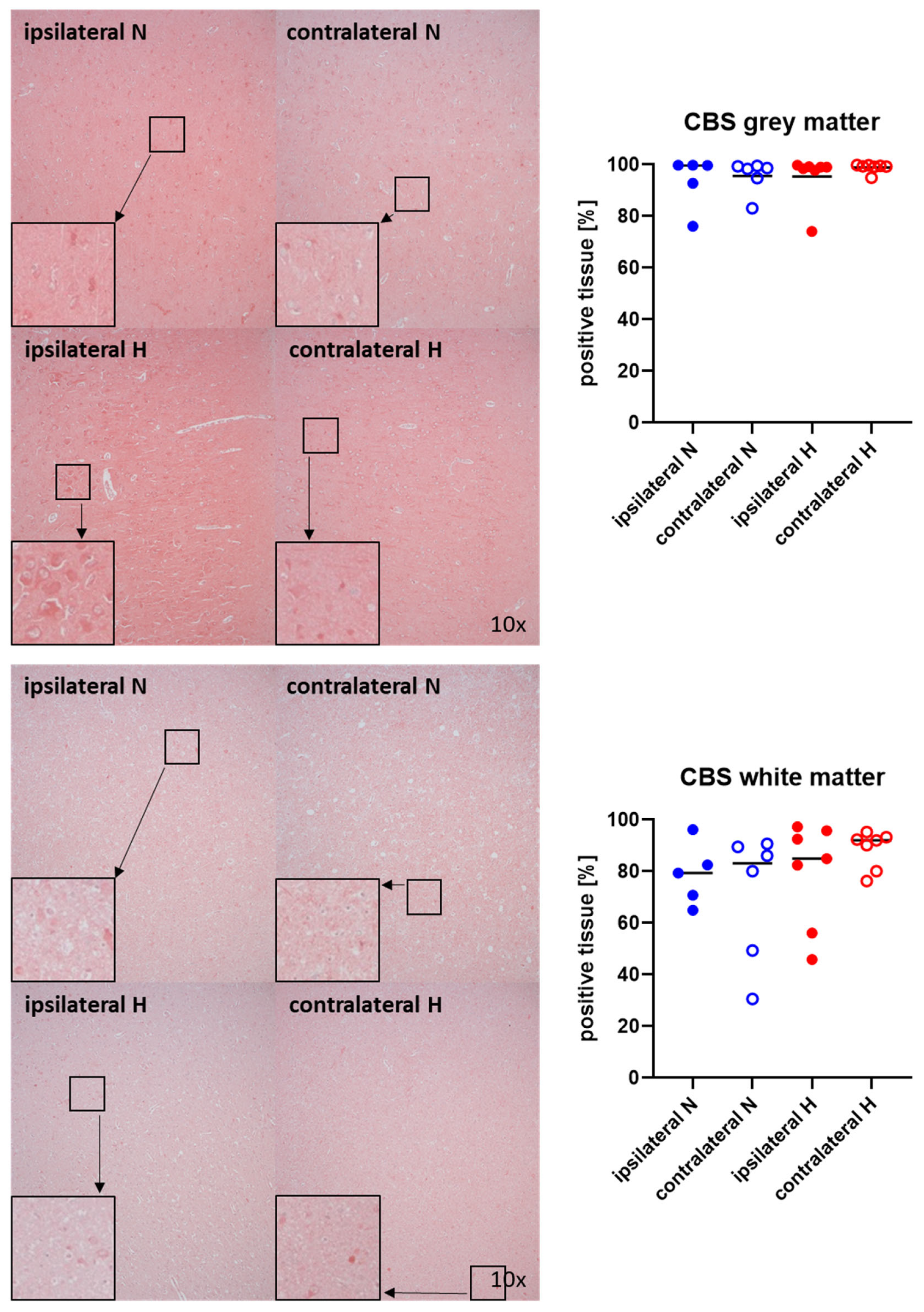
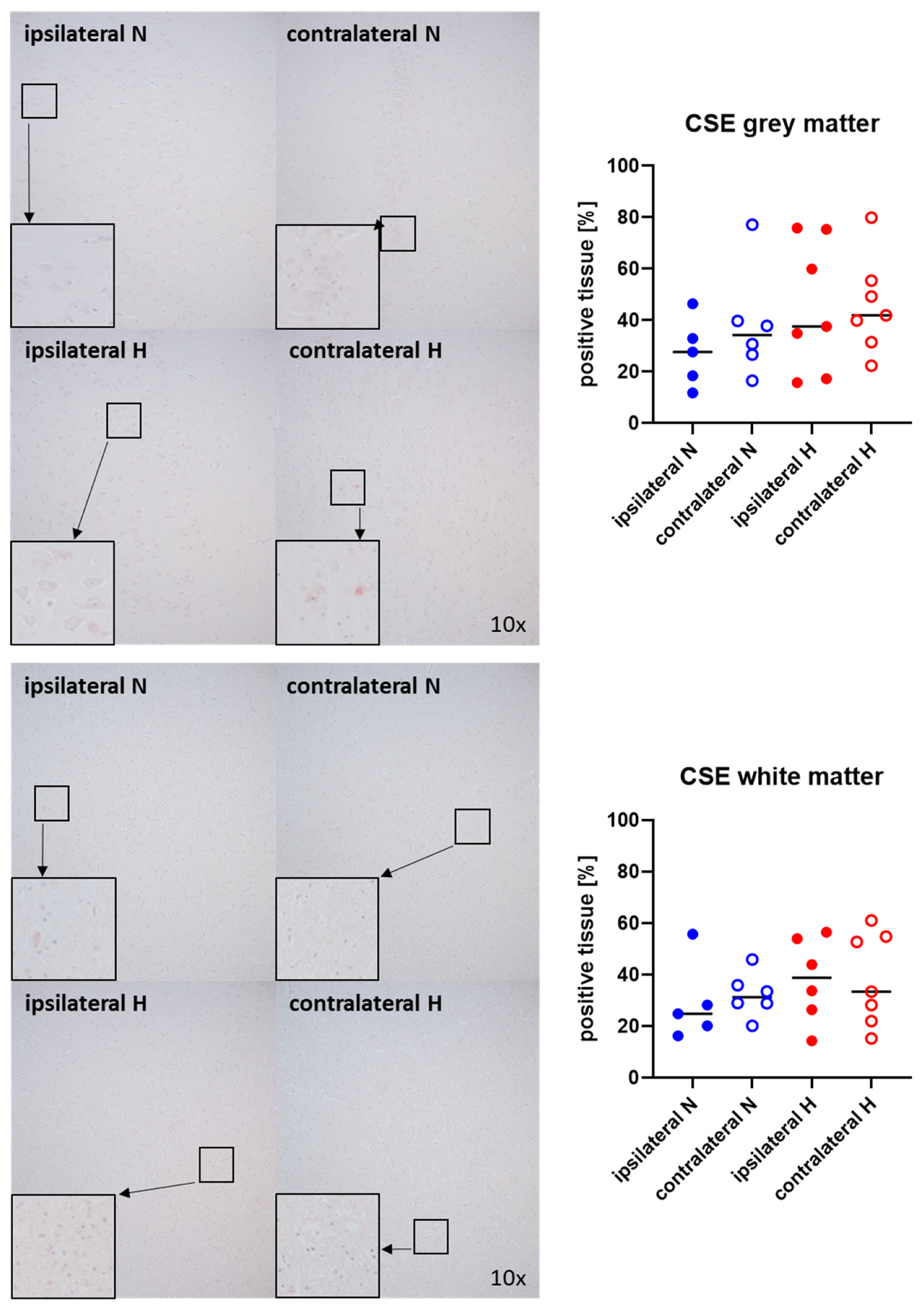
| Primary Antibody (Source, Catalog No., RRID) | Host Species | Immunogen Sequence | Concentration Used for IHC |
|---|---|---|---|
| anti-Albumin (Abcam, ab79960, AB_1658916) | Rabbit Polyclonal | Pig Albumin purified from pig plasma | 1:2000 |
| anti-CBS (Protein Tech, 14787-1-AP, AB_2070970) | Rabbit Polyclonal | CBS fusion protein Ag6437 | 1:200 |
| anti-CSE (Protein Tech, 12217-1-AP, AB_2087497) | Rabbit Polyclonal | Gamma cystathionse fusion protein Ag2872 | 1:200 |
| anti-Nitrotyrosine (Merck Millipore, ab5411, AB_177459) | Rabbit Polyclonal | Nitrated KLH | 1:200 |
| anti-OT (Millipore, Ab911, AB_2157629) | Rabbit Polyclonal | CYIQNCPLG (Synthetic oxytocin (Sigma) conjugated to thyroglobulin) | 1:500 |
| anti-OT-R (Protein Tech, 123045-1-AP, AB_2827425) | Rabbit Polyclonal | Oxytocin Receptor fusion protein Ag19074 | 1:100 |
Disclaimer/Publisher’s Note: The statements, opinions and data contained in all publications are solely those of the individual author(s) and contributor(s) and not of MDPI and/or the editor(s). MDPI and/or the editor(s) disclaim responsibility for any injury to people or property resulting from any ideas, methods, instructions or products referred to in the content. |
© 2024 by the authors. Licensee MDPI, Basel, Switzerland. This article is an open access article distributed under the terms and conditions of the Creative Commons Attribution (CC BY) license (https://creativecommons.org/licenses/by/4.0/).
Share and Cite
Münz, F.; Datzmann, T.; Hoffmann, A.; Gröger, M.; Mathieu, R.; Mayer, S.; Zink, F.; Gässler, H.; Wolfschmitt, E.-M.; Hogg, M.; et al. The Effect of Targeted Hyperoxemia on Brain Immunohistochemistry after Long-Term, Resuscitated Porcine Acute Subdural Hematoma and Hemorrhagic Shock. Int. J. Mol. Sci. 2024, 25, 6574. https://doi.org/10.3390/ijms25126574
Münz F, Datzmann T, Hoffmann A, Gröger M, Mathieu R, Mayer S, Zink F, Gässler H, Wolfschmitt E-M, Hogg M, et al. The Effect of Targeted Hyperoxemia on Brain Immunohistochemistry after Long-Term, Resuscitated Porcine Acute Subdural Hematoma and Hemorrhagic Shock. International Journal of Molecular Sciences. 2024; 25(12):6574. https://doi.org/10.3390/ijms25126574
Chicago/Turabian StyleMünz, Franziska, Thomas Datzmann, Andrea Hoffmann, Michael Gröger, René Mathieu, Simon Mayer, Fabian Zink, Holger Gässler, Eva-Maria Wolfschmitt, Melanie Hogg, and et al. 2024. "The Effect of Targeted Hyperoxemia on Brain Immunohistochemistry after Long-Term, Resuscitated Porcine Acute Subdural Hematoma and Hemorrhagic Shock" International Journal of Molecular Sciences 25, no. 12: 6574. https://doi.org/10.3390/ijms25126574
APA StyleMünz, F., Datzmann, T., Hoffmann, A., Gröger, M., Mathieu, R., Mayer, S., Zink, F., Gässler, H., Wolfschmitt, E.-M., Hogg, M., Calzia, E., Asfar, P., Radermacher, P., Kapapa, T., & Merz, T. (2024). The Effect of Targeted Hyperoxemia on Brain Immunohistochemistry after Long-Term, Resuscitated Porcine Acute Subdural Hematoma and Hemorrhagic Shock. International Journal of Molecular Sciences, 25(12), 6574. https://doi.org/10.3390/ijms25126574





